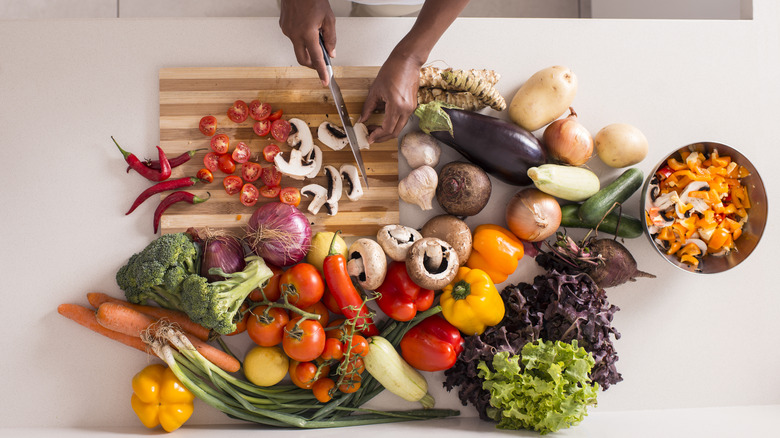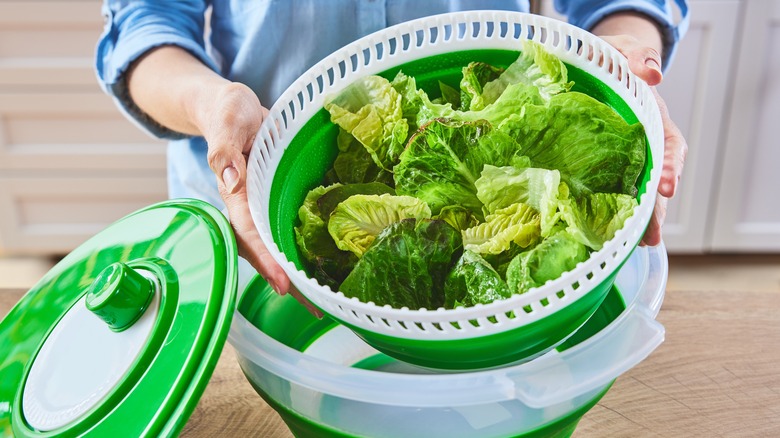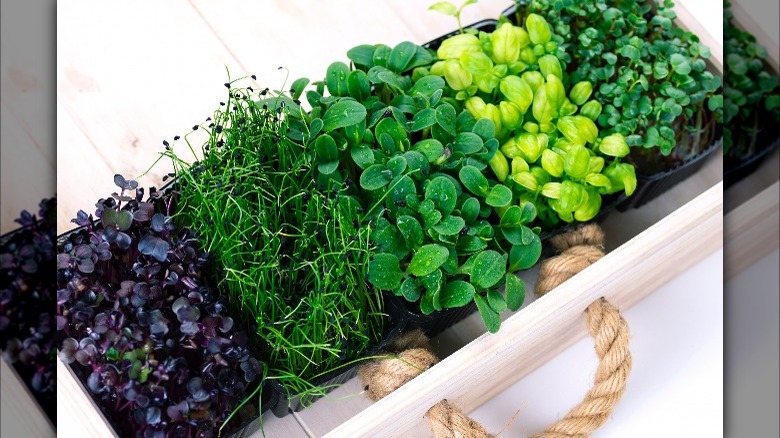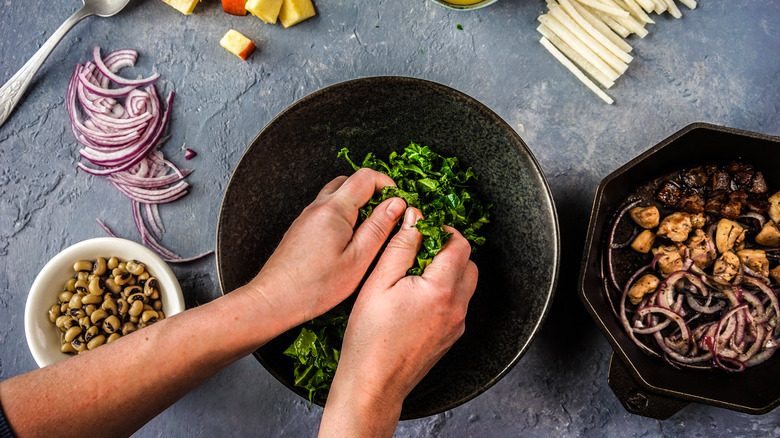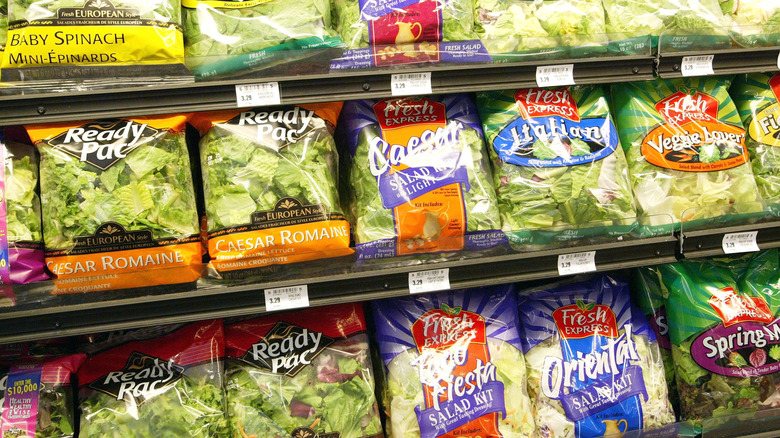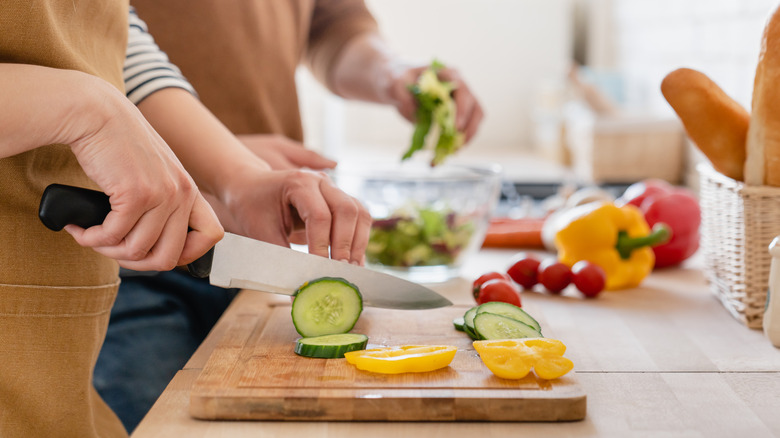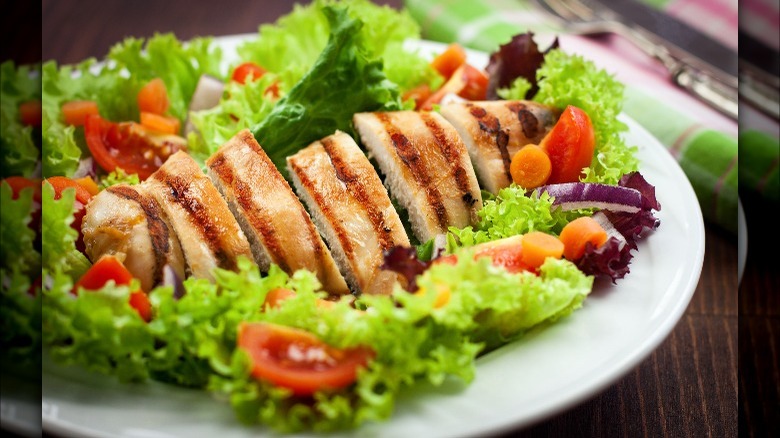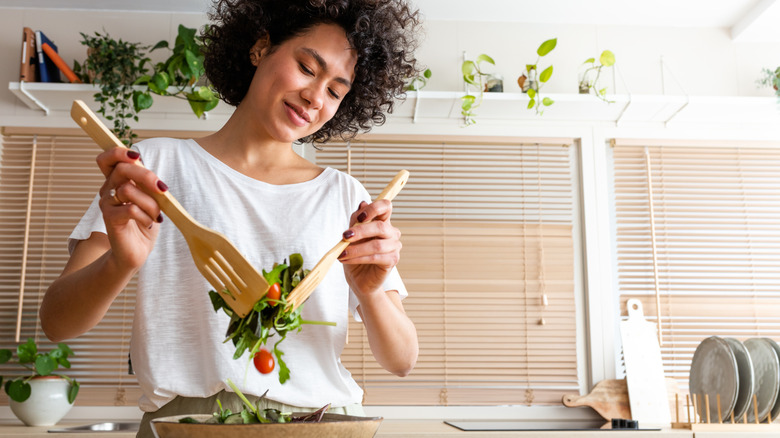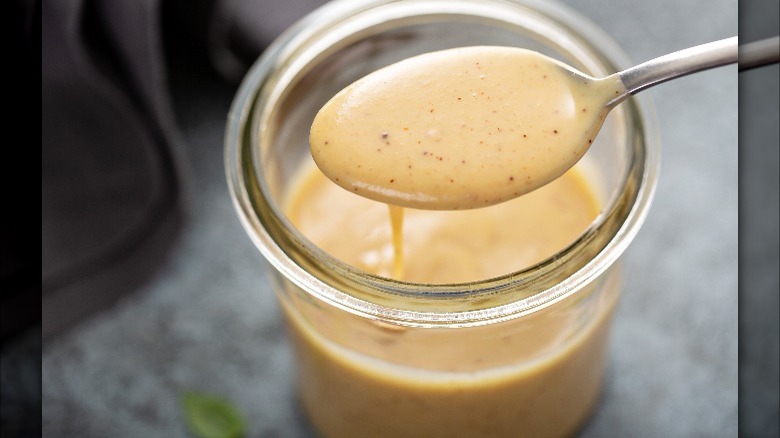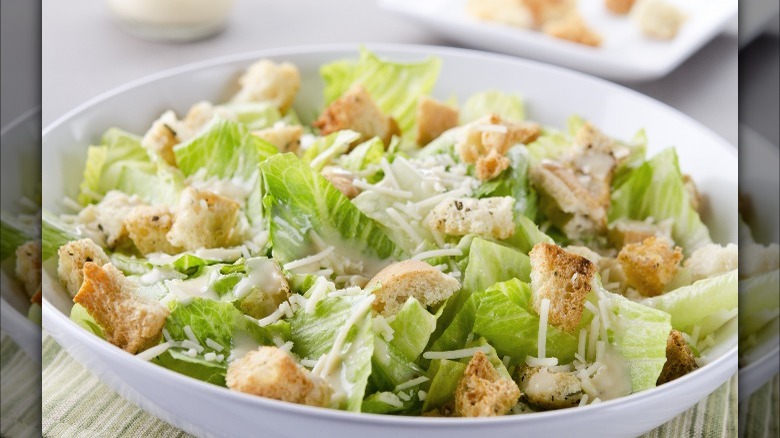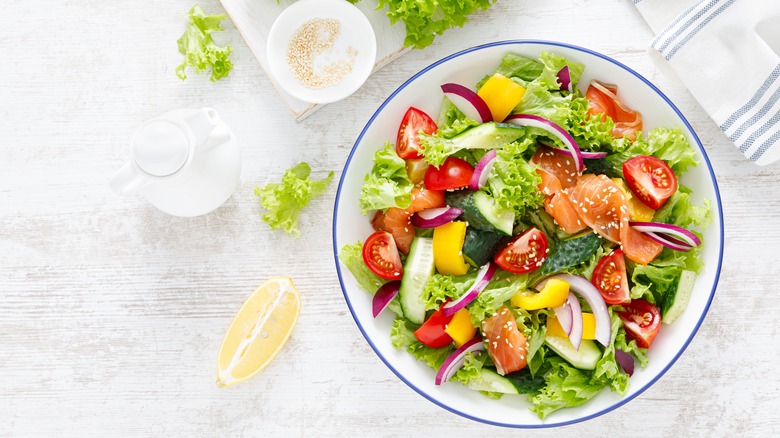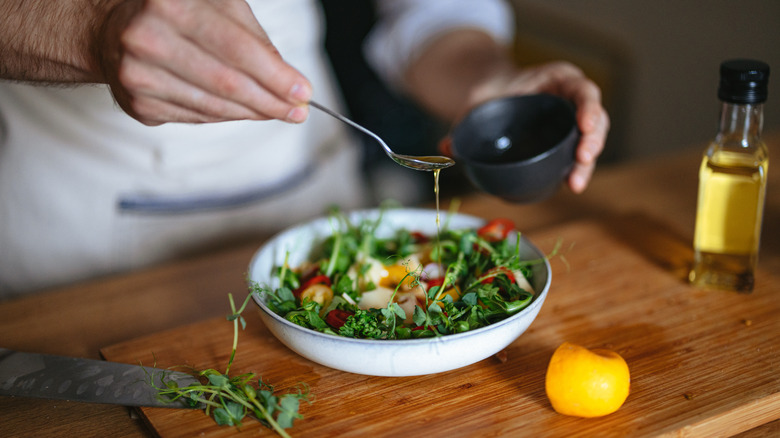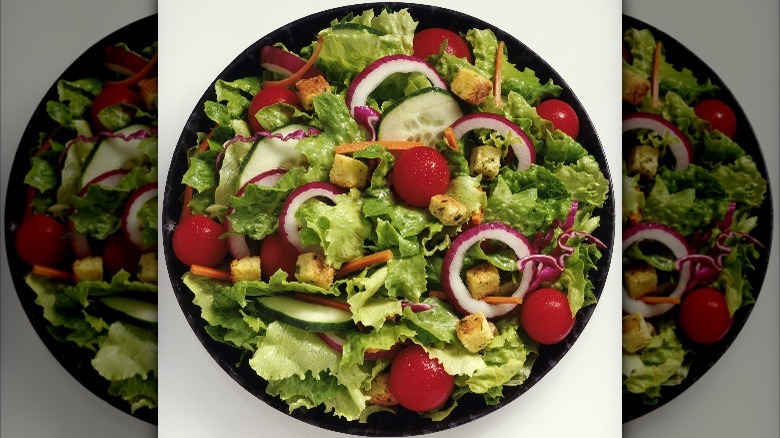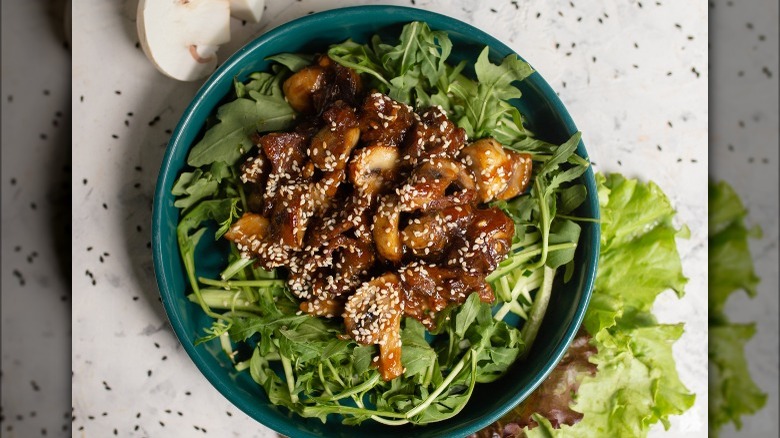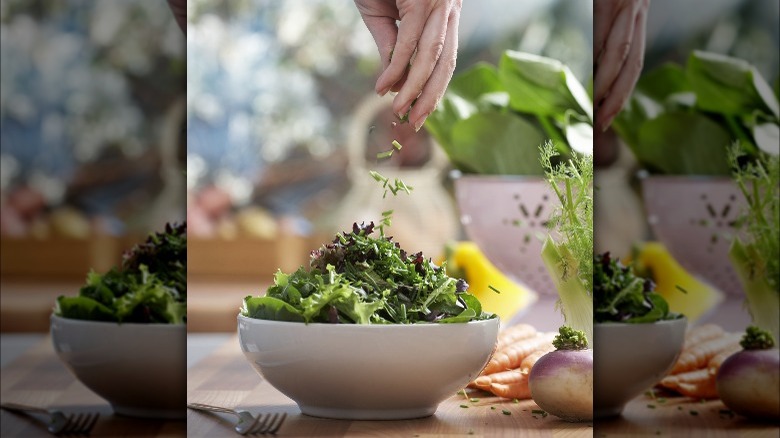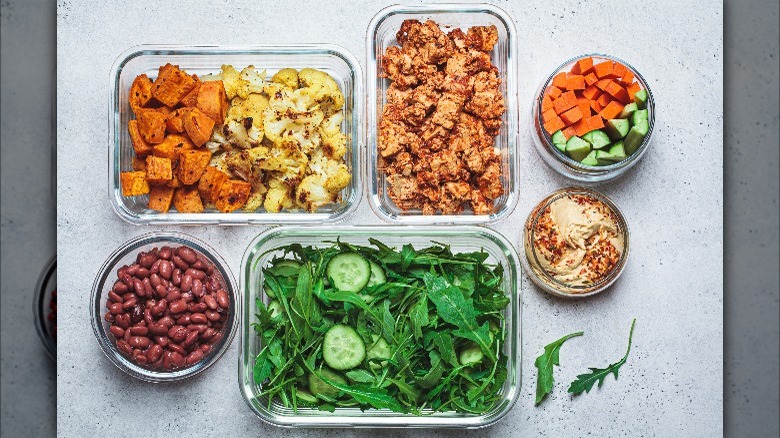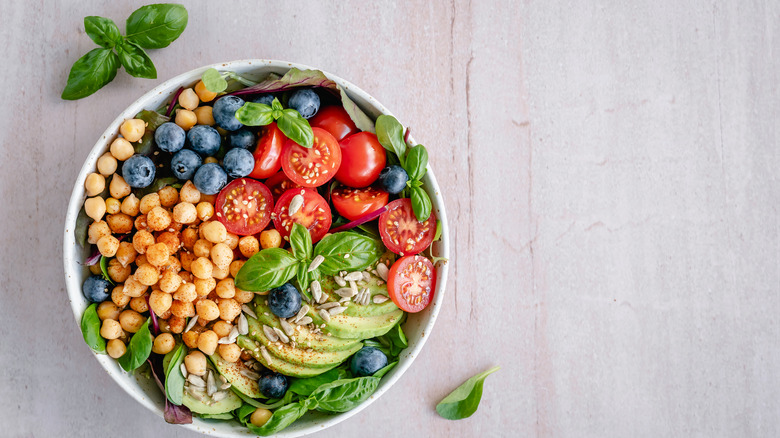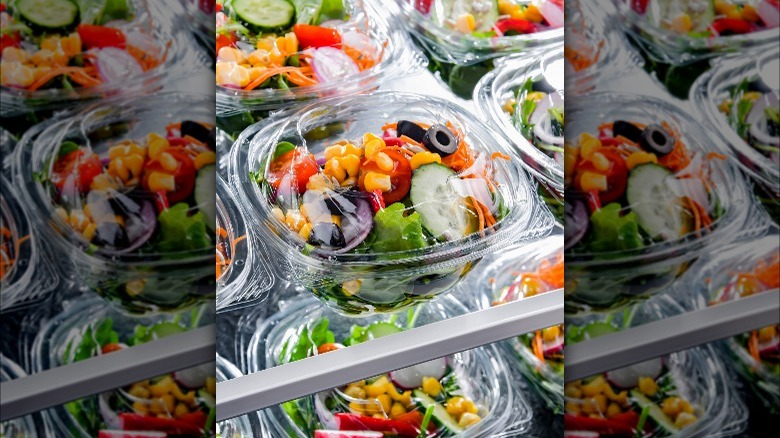20 Mistakes You Need To Avoid When Making Salad
Many people enjoy eating salads — whether they're served on the side of a meal or as a main course. Eating salads makes it easier to work more servings of healthy vegetables into your day. You may view a salad as a pretty basic food item. One so simple that certainly, no one could make any mistakes when preparing it. However, this is not actually the case.
There are several mistakes that people may make with preparing a salad. Who knows, you could be guilty of some of these mistakes and may just not realize it yet. For example, did you know that there is such a thing as too many croutons? Would you have guessed that it matters when you add the salad dressing? Does it surprise you to hear that the way a salad is presented on a plate can have an impact on whether someone will enjoy it or not?
If you want your salads to turn out fresh, healthy, and delicious, don't go anywhere. We're going to explore some of the many mistakes that people may make when preparing a salad. What mistakes have you inadvertently been making?
Not washing the lettuce
As far as safety goes, not washing lettuce before making a salad is one of the worst mistakes you can make. It is important to remember that lettuce grows in soil. Even if it looks clean, it may still be contaminated with bacteria from the soil, pesticides, or dirt. Because you're eating the lettuce raw, your risk of contracting a foodborne illness if you don't wash it is even higher than eating other unwashed vegetables that have first been cooked, according to Healthline.
There are a few different ways to wash lettuce. One way is to fill a large bowl with cold water. Pull the leaves off of the lettuce, discard the outer layer, and place them in the bowl of water. Submerge the leaves and let them soak for about 10 minutes. As the leaves soak, dirt and other debris will be released from the leaves and will soak to the bottom of the bowl. After 10 minutes, you can move on to drying the lettuce.
If you're only washing a few lettuce leaves, you can rinse them under cool, running water. Gently rub each leaf with your fingers as you rinse to help remove as much dirt and bacteria as possible. Then, lay the leaves out on a clean kitchen towel.
Not drying the lettuce
Washing lettuce isn't the only thing that needs to be done before adding it to a salad. It is also very important to dry your lettuce after cleaning it. If you don't dry lettuce leaves, your salad may taste off. The water on the leaves can dilute the dressing and prevent it from coating each leaf. Moreover, if you plan to store any of the lettuce for later use, it will go bad much quicker if it is wet.
There are several different ways to dry lettuce. One way is to use a salad spinner, which rotates the wet lettuce in a colander basket and pulls off the excess moisture. However, if you don't have a salad spinner, you'll still be able to dry your lettuce. You can lay your clean lettuce on a clean dish towel in a single layer. Gently roll the towel up and apply a very little bit of pressure to remove the excess water. Then, open up the towel, and check to see if your lettuce is dry and ready to use. Another option is to lay the lettuce out on a dish towel and use a second clean and dry cloth to gently pat each leaf down to dry it off.
Not adding other greens
Lettuce may be the green vegetable most commonly associated with salads. However, that doesn't mean that it is the only option you can use. You can add greens such as kale, spinach, or arugula to your salad as well. These greens alone or together with different types. Adding more greens to your salad can help you get more vitamins A, B, C, and K.
Beyond the larger greens that you'll find at the grocery store, don't forget that you can also add microgreens to your salads. Microgreens feature highly concentrated servings of calcium, iron, selenium, zinc, magnesium, and vitamins A, C, E, and K. According to Banner Health, adding them to your salads can help support a healthy immune system and improve gut health.
Not massaging kale and other tougher greens
You read that heading right. When you treat your kale, cabbage, Swiss chard, and some other tougher greens to a massage, it can improve the way they taste. When you massage some of these tougher greens, it helps tenderize them, making them more enjoyable to eat when you're ready to have the salad you make. Start by removing the thicker stems from the greens, then add them to a bowl. Add a tiny amount of sea salt and a hint of lemon juice, then grab the greens with your hands. Grab and squeeze the kale or other greens. Continue this until you feel them just beginning to wilt. Then, they'll be ready to add to your favorite salad recipe.
Using bagged lettuce
Bagged lettuce may seem like the best option when making a salad. After all, the lettuce is already washed and trimmed, making it ready for immediate use, right? Wrong. Bagged lettuce is more likely to be contaminated with bacteria than a fresh head of lettuce. This is because more people touch the lettuce during the preparation process, increasing the odds of something getting transferred to it. Think about how many recalls you've heard about for bags of lettuce. Bagged lettuce is also more expensive than fresh lettuce. If you go to the grocery store and compare how much lettuce you're getting for the price, you'll quickly realize that you're paying a lot for the convenience of having someone else wash it and cut it for you.
Cutting the vegetables into pieces that are either too large or too small
Cutting vegetables for a salad is a bit of an art. If you cut your vegetables into huge pieces, you're going to make the salad too difficult to eat. You or anyone else who is eating it will need to use a knife and a fork to cut the vegetables again to avoid taking multiple bites from the same piece. Conversely, if you cut the vegetables into very small pieces, they'll hardly be noticeable in the salad, and their flavor could end up getting lost. Either of these options will make the salad less enjoyable. Aim to make each vegetable piece large enough to taste without being too big to comfortably eat in one bite.
Not adding a protein
Not adding protein to your salads is another mistake you may be making. A salad with just lettuce and a few vegetables may taste all right, but it isn't going to be all that filling. However, if you add some protein to the mix, you'll be giving your salad more staying power to keep your belly fuller for longer. This can reduce snacking and help you achieve your health goals. There are several different types of proteins you can add to salad. Of course, you can top your salad with chicken, pork, beef, or other meats, but you could also add chickpeas, eggs, beans, or nuts to increase the protein content.
Not properly tossing
Did you know that not all tossing methods are equal when it comes to salad. If you've been using salad tongs to toss the different ingredients in your salad and distribute them evenly, you've been making a mistake. Using your hands is the best way to toss all the ingredients together. Doing so will incorporate more air into the salad, making it nice and airy instead of dense and more compacted. If you want to add dressing before tossing, you can still use your hands. Instead of pouring the dressing over the center of the salad in the bowl, drizzle it down along the walls of the bowl. As you toss the ingredients together, it will become incorporated with the mixture.
Another mistake related to tossing is adding all of the ingredients before you toss it. There are times that you may want to reserve some ingredients so that you can use them to top the salad. For example, if you have any bulky or heavy ingredients, like nuts or tomatoes, they'll all end up at the bottom of the bowl after tossing. Instead, add about half of these ingredients before tossing and save the rest to add to the top of the tossed salad. Doing so will ensure a more even distribution of these components.
Not making your own dressing
If you use store-bought salad dressings, then you have just identified another mistake you've been making. There are several reasons to consider making your own French vinaigrette, ranch, or Italian dressing. First, making your own dressing is easier than you may think. Most recipes only call for a few ingredients and will end up costing you a lot less than you'd spend to buy a bottle of dressing at the grocery store. But beyond the cost and ease of making your own, homemade dressings are also fresher and better for you. They don't include any of the thickeners, preservatives, or artificial flavors and colors that are added to many store-bought options. Plus, store-bought dressing just doesn't compare to the taste of homemade dressing.
Not adding some fresh fruit
If anyone has ever told you that you should only add vegetables — and not fruit — to a salad, they've given you some very poor advice. Fruit can most definitely be added to a salad, and doing so is a great way to experiment with new flavors and textures to make your meal more enjoyable. Strawberries, blueberries, apple slices, peaches, and cherries are just a few types of fresh fruit that can enhance both the flavor and healthiness of your salad.
You can also consider adding dried fruit to a salad. Dried fruit can give the salad a new texture and make it a little sweeter. A few dried fruits you may want to try on a salad include apricots, raisins, and cranberries. When adding dried fruit, remember that less is more. A serving of dried fruit is just ¼ cup, compared to a serving size of 1 cup for fresh fruits. This is because the sugar and calories in dried fruits is more concentrated.
Adding the croutons before you're ready to eat the salad
You don't always have time to make a salad when you're going to want to eat it. For example, you might want to make a salad the night before to bring with you to work the following day. Preparing your own lunch can help you save money and allow you to nourish your body with healthier ingredients. However, while you can mix many of the salad ingredients together well ahead of when you plan to eat it, you don't want to add the croutons until you're ready to eat the salad. If you add them in advance, they're going to be soggy, rather than nice and crunchy, when it's time to eat your salad. You can still make the salad ahead of time, just put the croutons in an airtight container or plastic bag to bring with you.
Adding too many croutons
There's another salad mistake you might be making that is also related to the croutons: Adding too many of them to top your salad. Sure, croutons are crunchy and delicious. You're not alone if you like adding them to your salad. However, if you've been piling them on your salad, you might want to reevaluate that choice. When you add croutons to a salad, you're adding more calories and fat to it. The croutons are made using butter or oil and are often fried. Look at the serving size on a box of croutons — it is likely a lot smaller than you may think. If you do want to use croutons, only add a few.
Not incorporating foods with different textures
A salad without different textures can be pretty unexciting. Consider upping your salad game by incorporating a variety of ingredients with different textures the next time you make one. Try to add a mix of chewy, creamy, and crunchy textures. Dried fruits are an excellent option if you're looking for something a bit chewier to add to your salad. To give it some crunch, consider nuts, raw broccoli, or jicama. To add a touch of creaminess, you can add some avocado or goat cheese — dressings can help you with this element. You can also sprinkle some sesame, sunflower, chia, or flax seeds over a salad to change its texture.
Not applying the dressing properly or at the correct time
Not properly dressing your salad is another mistake you will want to work hard to avoid. First, you should not put any dressing on the salad until you're ready to eat it. If you apply the dressing too early, the oils in it will get into the lettuce. Rather than being crispy and crunchy, your lettuce will turn out wilted and droopy. As mentioned earlier, the dressing also shouldn't simply be poured on top of the lettuce and other ingredients. Instead, you should pour some down each side of the bowl and gently toss the ingredients around. Doing so will ensure a more even application of the dressing. Ignoring this approach can leave huge clumps of dressing in some areas of the salad, while others will be completely bare.
Always making the same type of salad
A salad can make a healthy meal or side dish to a main course. However, if you always make the same type of salad, you're going to get tired of it. This can cause you to cut salads out of your diet, which can rob you of all the health benefits they have to offer. If you switch things up and try different types of salads, you can prevent your taste buds from getting tired of eating the same things over and over. Different ingredients will offer very unique flavors. Even if you eat a salad every day, if you change up the toppings frequently, you are less likely to get bored with your healthy choices. Play around with different options, such as a cobb salad, a Caesar salad, a wedge salad, a Greek salad, a chef salad, or a Southwestern salad.
Thinking you can only add raw vegetables to a salad
While you most commonly see raw vegetables on salads, there is no rule stating that you cannot add cooked vegetables too. In fact, adding some roasted or steamed vegetables can help enhance the flavor of your salad. Roasted mushrooms, steamed asparagus, and sautéed zucchini are just a few options to consider. You can reduce food waste by adding leftover cooked vegetables from your previous day's meals. In addition to adding a few cooked veggies to your salad, you could also further expand your options by tossing on some pickled cabbage, cauliflower, beets, bell peppers, or other vegetables.
Not adding fresh herbs
If you want to make a flavorful and more upscale salad, then adding fresh herbs is a must. There are so many different types of herbs available to choose from, most of which are easy to find at the grocery store or even to grow in your kitchen. Let's take a look at a few of the most popular options, though don't feel limited to only these choices. You can really add any of your favorite fresh herbs to your salad.
Cilantro is one of the herbs you may want to try on your salad. It is frequently used when preparing Indian, Asian, and Latin dishes and has a rather strong flavor. Basil is another option. It is an aromatic herb that can add a slightly minty and peppery flavor to your salads. If you like onions, you might enjoy a salad with chives. They are a bit milder than a true onion but will still add a similar flavor profile to your salad.
Not meal prepping and making multiple salads at the same time
If you plan to eat several salads over the course of the week, then you're making more work for yourself if you make each salad individually right when you're ready to enjoy it. This simply isn't an efficient approach. You'd be much better off prepping all of the salads at the same time and putting them in an airtight container in your fridge. Just remember to package the dressing and croutons separately. Prepping several salads at once will cut down your overall work time. Even if you're planning to add different toppings to your various salads, there is still likely to be some overlap in the ingredients, and you'll save time getting everything ready all at once. Plus, your future self will certainly be thankful when there is a salad for lunch or dinner sitting in the refrigerator, ready to eat.
Not paying attention to presentation
Did you know that the actual flavors in a dish aren't the only thing that can affect whether you enjoy the way it tastes? The way something looks can actually impact the way our brains perceive its overall taste and how enjoyable it is. This means that spending a few extra minutes to make your salad look nicer can actually make it taste better to you. If you're stumped on how to make a salad look more attractive, there are a few different things you can do. One is to put a little effort into how you lay out the veggies and protein topping the salad. Another idea is to be purposeful when deciding which veggies you want to add to the salad. Try to choose veggies in a variety of different colors, such as purple cabbage, red peppers, broccoli, orange carrots, or heirloom tomatoes.
Not storing the salad properly
If you don't store lettuce or prepared salads properly, the lettuce leaves and other vegetables are going to turn soggy or spoil much more quickly. When storing lettuce, always make sure that it is fully dried first. Too much moisture will cause it to go bad faster. Even once the lettuce is dried, there will still be some moisture in the container. Laying a paper towel along the base of the container before adding the lettuce and then directly over the lettuce before sealing the container can help. The paper towel will absorb excess moisture to keep the leaves as dry as possible.
